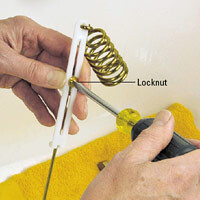Using Augers
A hand-crank auger clears most household clogs. It consists of a metal cable with a widened tip that grabs or pushes debris. Power-operated augers work quicker, but a fast-turning auger can get stuck so tightly you cannot extract it.
You can run an auger through the sink and into the trap rather than dismantling the trap. However before doing so on a bathroom sink, you’ll need to remove the pivot. It’s usually not possible to auger a kitchen sink because of the garbage disposer and because the drain assembly for a double-bowl sink has too many turns.
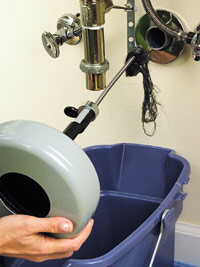
If a tub drains slowly, hair and soap sludge may be stuck to the drain assembly. A plunger-type assembly is less complicated and less likely to clog than a pop-up assembly, but both need occasional cleaning.
A toilet auger is the solution when plunging fails. Otherwise remove the toilet to auger out the clog.
Checklist
Time - About 2 hours to dismantle a trap and auger a branch line
Tools - Groove-joint pliers, hand-crank auger
Skills - Dismantling and reinstalling a trap
Prep - Make the worksite comfortable; place a bucket under the trap to catch spills
Materials - Replacement washers for the trap
Step 1
Dismantle the trap. Loosen the auger setscrew and pull out about a foot of cable. Push the cable through the pipe until it stops. You’ve probably run into a bend in the pipe rather than the obstruction. Tighten the setscrew. Crank clockwise until the cable moves forward.
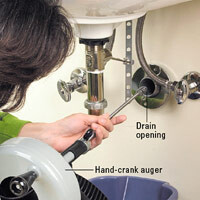
Step 2
Loosen the setscrew, push the cable until it stops, tighten the setscrew, and crank again. The auger may grab rather than push the obstruction. If so pull out the auger, clean away any hair and gunk, and reinsert the auger to remove more of the obstruction.

Cleaning a pop-up (rocker-arm) type assembly
Step 1
If the tub has a pop-up assembly, flip the trip lever up to raise the stopper. Gently pull the stopper and the rocker arm up and out of the tub. Clean away any debris.
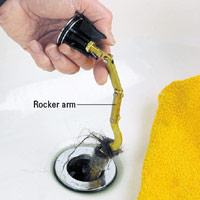
Step 2
Remove the cover-plate screws and pull out the cover plate with the linkage connected to it. Clean away any hair, coagulated soap, and other debris that might be attached to the linkage.
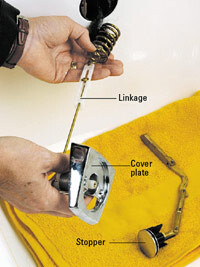
Step 3
If the stopper does not seal completely, loosen the locknut and twist the threaded rod so it rises up about 1/8 inch. Tighten the locknut. Reinstall and test.
